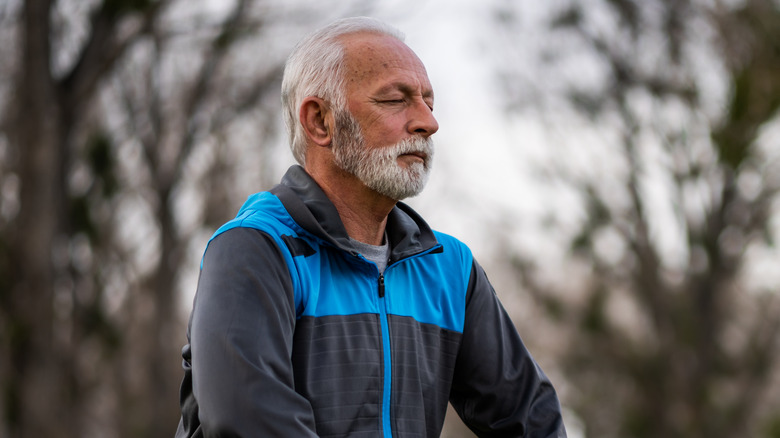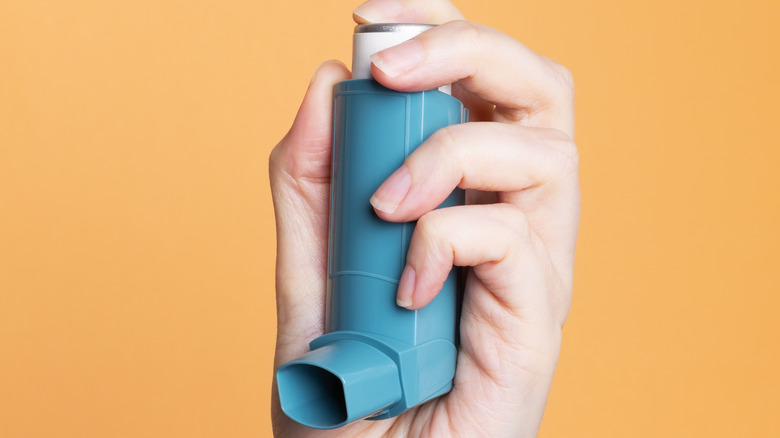The Best Exercises For Asthma
If you're one of the approximately 20 million adults that has asthma in the United States (per the Asthma and Allergy Foundation of America), you'll know how important it is to manage your condition. Asthma symptoms can occur as a response to a range of triggers, from dust to pollen to specific foods.
Exercise is also something that people with asthma have to consider pretty carefully. Asthma symptoms caused through physical exertion, also known as exercise-induced asthma or exercise-induced bronchoconstriction, manifest as your airways narrow in your lungs as a result of working out, with symptoms like coughing, wheezing, and difficulty breathing being common (per the Mayo Clinic).
But here's the catch-22: Folks with asthma are likely well aware of the importance of physical exercise for physical and mental health, and yet doing so can trigger an asthma attack. So what do they do? Well, luckily, there is a range of exercises out there that you can still safely partake in, as they are less likely to result in an asthma response — and we've got them all here.
Yoga
We're willing to go on record and say that yoga is one of the best exercises for pretty much anyone out there, but it's especially good for people with asthma. In addition to offering a workout that promotes flexibility and muscle tone without overtly straining the lungs, yoga is infinitely adaptable to skill, fitness level, and the desired intensity of exercise, meaning that you can reduce or increase how hard you want to work out depending on your level of asthma.
Furthermore, with its emphasis on the breath-body connection, yoga may help with breathing control and chest opening, potentially easing asthma symptoms and attacks (per Medical News Today). In fact, a study published in the Ethiopian Journal of Health Science found that asthma patients who did yoga experienced a "significant reduction in day and night asthma attacks" — although it should be noted that this was a small-scale study, and further research is needed. Yoga is also a seriously calming form of exercise to promote relaxation and reduce stress (a factor for many people living with asthma), says yoga instructor Julia White, who documented her own experiences as a yoga practitioner with asthma for Asthma and Lung UK.
Swimming
There are so many benefits to swimming — improvements to mental health and sleep quality, muscle tone, general cardiovascular fitness, and more (per Women's Health Magazine) — that it's hard to keep track of them all. And folks who have asthma should feel secure that they can reap these rewards as much as anyone, with swimming being one of the best exercises out there to partake in.
Research published in Sports Medicine claims that there are "definite benefits" to swimming as an exercise for people with asthma, with exercise-induced bronchoconstriction being less prevalent than in other sports, as well as fewer incidences of death associated with asthma for swimmers and better aerobic fitness overall.
Part of the reason why swimming's so good for people with asthma is down to the standard environments of swimming pools, which have warm, humid air that stimulates the lungs less (via Just Swim). Bear in mind, though, that the chlorine used in swimming pool water may act as an irritant for some people, making swimming in some environments more difficult. For this reason, it's worth taking things slowly to start, and exiting the pool if you notice a strong chemical smell. Keep your asthma inhaler close to hand and ensure that you're getting into the pool after having warmed up, cooling down properly afterward, to lessen the chance of an asthma attack.
Hiking
There are few things more gratifying in life than being out in the open air on a good old hike. Seeing nature in all its glory with your friends by your side, what's not to love? And luckily, hiking is a seriously viable form of exercise for people with asthma. Gentle hiking is the way forward with this, says Healthline. Make sure that you're not following a trail that gets too steep or mountainous, with flat hiking paths being best to not overwork the lungs.
However, all of us know that hiking terrain can frequently be unpredictable, and if you find yourself at the bottom of a hill with no way but up, you must be prepared. Ensure that you pack your inhaler before you head out, and make doubly sure that it's the right type. Albuterol inhalers are generally prescribed for people who experience exercise-induced asthma, with albuterol working to dilate your bronchial tubes, according to Backpacker. It's also very wise to give a spare inhaler to the person you're hiking with, and to instruct them on how to help in case you start to experience symptoms.
Golf
We're big fans of golf, folks. Honestly, a sport that allows you to spend hours outdoors, bolsters heart health, and reduces stress (per Better Health)? We're signing up for our nearest golf club immediately. And if you have asthma, you'll be pleased to hear that golf is still firmly on the agenda. Golf is typically pretty gentle on your lungs, with the sport involving a good amount of walking interspersed with spikes of energy when you swing, as Active Healthcare, Inc. says. As a result, it's far less likely to trigger an attack than other, more heavy-duty forms of exercise.
However, given that golfing requires you to spend a lot of time outside, there's one thing that people with asthma would do well to consider: The pollen count. An increase of pollen in the atmosphere can trigger hay fever symptoms, and these, in turn, can worsen asthma symptoms or contribute to asthma attacks, says Asthma and Lung UK. If you're an avid golfer, it's important to prepare for the possibility of hay fever flare-ups in advance. Ensure that you're stocked up on antihistamines and are taking them regularly during high pollen seasons, as the majority of people with hay fever are affected between May and July by grass pollen.
Tai chi
For gentle yet effective exercise, it's difficult to go wrong with tai chi. Don't let the apparent ease of tai chi fool you: Despite its slow speed, tai chi's focus on control and continuous motion means that it has real benefits to your muscle strength and endurance, says WebMD. Tai chi can also improve your energy levels, help you become more flexible, improve your heart health, benefit your mood, and improve your aerobic health thanks to its emphasis on deep breathing. Okay, we're sold.
And all of this is very good news for people with asthma, who can count tai chi as one of the most viable forms of exercise out there. In fact, tai chi isn't just a safe exercise for asthmatics — it could also benefit their health. A study published in Evidence-Based Complementary and Alternative Medicine found that children with asthma who practiced tai chi experienced less inflammation in their airways and had better lung function, a trait that was also observed in children without asthma. The children with asthma also found that they had an overall better quality of life. It should be pointed out, though, that the children who took part in the study were classified as having "mild" asthma, and for individuals who have more severe symptoms, further study is needed to determine tai chi's exact benefit.
Free downhill skiing
Skiing gives us a connection to nature that few other sports can generate, but is it off-limits to people with asthma? In the case of free downhill skiing, you'll be pleased to hear that it is very much still a possibility for a lot of people. Free downhill skiing is particularly well-suited to asthmatics thanks to the nature of the exercise being a series of short bursts instead of longer, steady-state activity, says Johns Hopkins Medicine. This puts less continuous pressure on the pulmonary system, and is therefore less risky for asthma attacks.
But what about the cold air when you're skiing? Surely that's a trigger for asthma attacks, right? Not necessarily. While cold air can be a factor in increased asthma symptoms, it's generally the dryness of the air that causes a response, not the temperature itself, as the Allergy & Asthma Network discusses. It's also important to remember that while free downhill skiing might be less impactful thanks to its decreased pressure on the lungs, other types of skiing aren't as easygoing. "With cross-country skiing, there's a higher ventilation rate of breathing and there's a lot of heat and water loss from the airways," says Allergy, Asthma and Immunology Clinic of Colorado allergist and University of Colorado clinical professor William S. Silvers. Be wary if you're practicing cross-country skiing, and always consult with your doctor before any type of skiing activity if you have asthma.
Walking
It's hard to go wrong with walking as an exercise for people with asthma. Walking is a workout that won't put too much strain on your lungs, and it doesn't inhibit your ability to breathe or increase your risk of asthma symptoms significantly (per Healthline). Additionally, people who have asthma will get an almost unbelievable list of health benefits from partaking in this rather unassuming exercise.
"Walking improves fitness, cardiac health, alleviates depression and fatigue, improves mood, creates less stress on joints and reduces pain, can prevent weight gain, reduce risk for cancer and chronic disease, improve endurance, circulation, and posture, and the list goes on..." says fitness studio owner and former heptathlon world athlete Ann Green (via NBC News). Are those enough reasons for you?
Walking's also an exercise that you can do with friends, adding a social aspect to your workouts, which we're very much here for. Just keep in mind the weather when you're walking: As asthma symptoms can be triggered by drier, colder conditions, it's best to time your walks for when it's as warm as possible. If this isn't an option, using a treadmill to get your steps in is a great move.
Biking
Biking is one of those exercises that is as fun as it is beneficial. And luckily for people with asthma, it's also a particularly good workout to avoid or limit symptoms. Biking provides a useful workout without putting too much stress on the lungs at lower intensities, and may even help to improve lung health, the Bernstein Allergy Group Inc. states. And bear in mind that you don't necessarily have to be outside to do it — an exercise bike will provide the same benefits.
Importantly, though, don't overdo it when you're cycling: Gentle rides will provide a better balance of benefits while avoiding any serious impact on your lungs. And the great thing about cycling if you have asthma is that you'll get a host of additional positives. Cycling is absurdly good for your leg and lower body strength, with your muscle tone and strength able to increase without your joints becoming too impacted, says Healthline. Biking also gives your mental health a boost, especially if you're taking an ultra-gorgeous, scenic route. Lastly, it can promote better heart health, increase balance and coordination, and may even lower your cholesterol levels.
Tennis
If you're like us, you suddenly get very interested in tennis every time a major tournament rolls around, and then all of a sudden, that enthusiasm wanes (usually after you've spent exorbitant amounts of money on a racket and balls, which are destined to collect dust forevermore). But if you have asthma, we'd strongly encourage you to keep that tennis habit going year-round.
Tennis is an exercise with frequent in-built rests between points and games, so you're not having to constantly expend energy, which your lungs will thank you for (per Allergy Los Angeles). Additionally, you're able to have a water break and a breather whenever you need to, and it's really easy to moderate your pace and intensity. Playing doubles will also make it less impactful, and as a bonus, you get to hang out with your friends while you do so!
Just make sure that you're warming up before you head to the court. Slowly easing yourself into increased physical activity through a light warmup of stretching or walking will prepare your body for the more intense exercise that's about to come, as well as reduce the likelihood of breathing difficulties, says WebMD.
Volleyball
If you haven't played volleyball since you were a kid (or that summer, years ago, with your friends on the beach — you know the one we're talking about? Where the weather was just perfect, and you fell in love with that pers- Okay, we're getting sidetracked here), perhaps it's time to pick it back up.
Volleyball is a great exercise for people with asthma, especially for children who have the condition, according to pulmonologist Mayan Shukla (via the Asthma & Sleep Institute). This is thanks to the nature of volleyball being an exercise made of up shorter bursts of movement and exertion, which is less triggering for your lungs, as the Asthma and Allergy Foundation of America notes. It is useful to note that volleyball is still slightly more vigorous than other types of exercise, thanks to the level of running that can sometimes be involved — but when playing on a team with a group of other people, you should still be okay to get through a match. Just make sure you're keeping an eye on your exertion and pull back or stop if you're worried you're pushing yourself too much.
Short-distance running
If you have asthma, you may well assume that running is a total no-go zone. But you might find that, for shorter distances, running may still be a viable option. Short-distance running, and sprinting in particular, could still be a useful form of exercise for people with asthma, thanks to the bursts of energy required necessitating less continuous work from the lungs (per Healthline). This allows you to reap the benefits of sprinting as exercise, of which there are many, including an increased rate of fat and calorie burn and a better capacity for muscle building (per Stack).
It is also possible to run longer distances if you have asthma, provided you take the necessary precautions, Healthline states. Timing your runs so that the weather conditions are optimal for your asthma is a good place to start, with lower pollen counts and early-morning weather conditions generally being preferable (although if the air is especially cool and dry in the morning, this may not be the case). Ensure that you carry your inhaler with you, and crucially, don't go all out on the first attempt — start slow, warm up your body, and be very aware of what your limits are, stopping if there's any sign of difficulty. It's important to talk through your exercise options with your doctor if you have asthma, to see if running is feasible.
Baseball
Baseball is one of those exercises that a lot of people love to take part in once or twice a year, and then forget about. But we're here to tell you, folks, that baseball is firmly on our year-round list, especially if you have asthma.
Baseball is a sport that's made up of short, intense bursts of activity, making it ideal for asthmatics, according to Kids Health. This means that you're generally breathing less deeply and quickly than you are if you're doing an activity that requires continuous activity, and as a result, there's less opportunity for potential triggers to make it into your lungs (per Johns Hopkins Medicine). It's these triggers — cold and dry weather conditions, potential allergens like pollen or dust, air pollution, or chemicals — that aggravate your airways, resulting in exercise-induced bronchoconstriction (EIB).
An added benefit for baseball (and not just in terms of physical health) is that you get to exercise as part of a team. This is more beneficial for mental health and reducing the risk of anxiety and depression than solo sports, per a study published in the Journal of Sports Science and Medicine.
What exercises are worst for asthma?
As it turns out, there are loads of sports out there that are safe and beneficial for people with asthma to do. But which exercises aren't so good?
Exercise-induced asthma is generally triggered by increased activity in your lungs. Therefore, any workouts that require continuous deep breathing and energy expenditure are going to be potentially more triggering. This could include exercises like distance running, soccer, field hockey, and basketball, all of which involve long stretches of physical activity (via WebMD).
It's also important to think about the environment you're working out in, as combining longer-period exercise with cold, dry air conditions could be a recipe for disaster. Exercises like ice skating and cross-country skiing, as well as ice hockey, might be especially problematic for asthmatics. For any exercise that people with asthma perform, they should seek to use bronchodilators before working out to reduce the risk of triggering symptoms. If you're exercising in the cold, no matter the intensity of the exercise, seek to cover your nose and mouth, to lessen the cold air making its way in.
How to treat exercise-induced asthma
While it is entirely possible to work out with asthma for many people (provided that you're taking the right precautions), there's still a possibility of symptoms being provoked. And when exercise-induced asthma occurs, you must respond quickly.
The first thing to do if you or someone you're with is having an exercise-induced asthma attack is to cease activity immediately, according to WebMD. Find somewhere to sit and allow the body to come back to its resting state. While this happens, if your doctor has specified a plan of action for whenever you have an asthma attack, follow it instantly — but if that's not the case, use an inhaler while loosening any tight, restrictive clothing, sitting in an upright position (per WebMD).
If symptoms start to abate and you return to normal, then it may be safe to continue exercising, but it's crucial to take things slower than before and to stop immediately if you're concerned about symptoms returning. If things don't subside, call a doctor or 911. Remember that for most people with asthma, exercise is entirely possible — athletes at the top of their game, like Jackie Joyner-Kersee and Jerome Bettis, live with the condition, per Healthline – but the management of your symptoms, as well as awareness of your limits, is essential.














